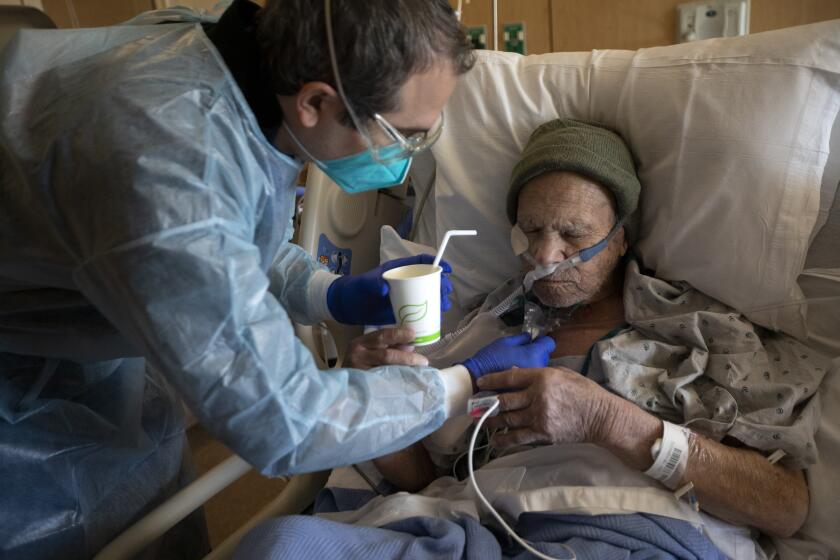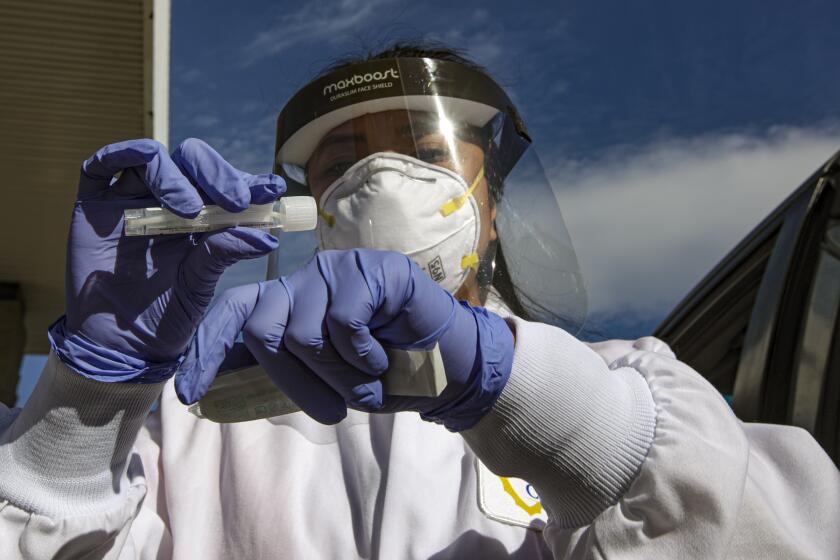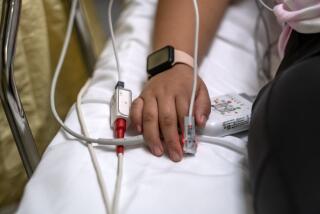Feared post-Christmas coronavirus surge appears to begin in L.A. County as cases top 800,000

The dreaded post-Christmas spike in coronavirus cases appears to be materializing in Los Angeles County, with a new rise in cases as hospitals are already in crisis from the Thanksgiving surge.
The county reported 19,063 cases on New Year’s Day, its third-highest single-day total, and 16,603 on Saturday, its fifth-highest total, according to an independent Times tally of local health jurisdictions. That means that over the last three days, an average of more than 16,000 new cases a day have been reported in the county — one of the highest such tallies on record.
Saturday’s tally pushed the county’s cumulative number of cases past 800,000. In a sign of how rapidly the coronavirus is spreading, more than 400,000 of those infections were reported since Dec. 1.
“This is the fastest acceleration of new cases than at any other time during the pandemic,” the L.A. County Department of Public Health said.
More L.A. County residents are dying daily of COVID-19 than at any other point in the pandemic — an average of 178 deaths a day over the last week, the equivalent of one death every eight minutes, according to a Times analysis. Of L.A. County’s cumulative death toll of more than 10,600, more than 3,000 have been reported since Dec. 1, including 136 on Saturday.
With hospitals already overflowing, officials have been dreading another spike in cases, which experts say would worsen conditions through January.
Just a week ago, there were some encouraging signs that new cases in the county were slowly stabilizing — leveling off at around 13,000 to 14,000 a day — as the stay-at-home order began to show results. But that brought little celebration, because those numbers were still so high that they would continue to overwhelm hospitals and because health officials were convinced that gatherings during the Christmas holiday would quickly erase those gains.
Dr. Robert Kim-Farley, medical epidemiologist and infectious diseases expert with the UCLA Fielding School of Public Health, said Saturday that he expects cases to mount over the next two weeks as people exposed to the virus over Christmas and New Year’s fall ill and get tested. This would be similar to the trends from Thanksgiving.
If those trends hold, hospitals are expected to be at their peak crisis by the end of January and COVID-19 deaths would peak by mid-February, he said.
“Given that persons will, hopefully, be traveling less and having fewer gatherings in their homes after these recent back-to-back holiday celebrations … we should begin to see some downturns in the disease rates by the end of January,” Kim-Farley said.
The number of daily cases in late winter should also begin to fall because many people who end up surviving the coronavirus infection will develop immunity, Kim-Farley said.
This level of protection won’t result in full “herd immunity” that protects the full population, but “it should result in decreased numbers of new cases in those who are not following public health guidance on masking and physical distancing,” Kim-Farley said.
It will only be when 70% to 85% of the population has received the vaccine, which Kim-Farley estimates will occur by early summer, that “true herd immunity will begin to be reflected in a more rapid drop in the numbers of new cases in the population,” Kim-Farley said. “By late summer or early fall, we should be able to get back to a semblance of our life in the pre-COVID era with greatly reduced restrictions on our activities, businesses and schools.”
And as more of the elderly and people in nursing homes are vaccinated, “we should see some drops in hospitalizations and deaths because residents in nursing homes make up such a larger percentage ... of all deaths due to COVID,” Kim-Farley said. But there might be a delay in seeing a large drop in new daily cases, “since so many younger people are now coming down with the disease.”
“It’s mentally, physically and emotionally draining,” said Dr. Nick Kwan, who struggled to articulate the toll that COVID-19 has placed on patients and L.A. County hospitals.
Officials had urged more people to stay home over the winter holidays than during Thanksgiving, and there was some hope more people might have complied. The Rose Parade was canceled for the first time since 1945 and Pasadena was an eerie calm.
But the same kind of pandemic fatigue seen over Thanksgiving led many people to defy officials’ pleas to stay home for the winter holidays. Many airports saw steady traffic from holiday travelers. And thousands of New Year’s revelers were dispersed, detained or arrested through the weekend in Southern California as large celebrations and parties occurred across the region.
Los Angeles Police Department officials said they broke up at least eight New Year’s Eve gatherings involving more than 2,000 people downtown and in the surrounding area, including one warehouse party where more than 1,000 people were dispersed. Sheriff’s officials said they broke up at least five parties involving more than 900 people — including at a rented house, a vacant warehouse, a hotel and a closed business.
Lt. Raul Jovel, an LAPD spokesman, said LAPD officials were “all monitoring social media” this week to identify planned parties. The work wasn’t easy, in part because party hosts “are getting smarter,” he said. Promoters often announce a party in a general area — like downtown — but won’t post the address until the last minute or not at all, relying on it spreading by word of mouth instead.
Social media “influencers” and other young partygoers posted footage on social media of revelers ringing in the New Year the old-fashioned way — by screaming, dancing and singing together in enclosed spaces without masks.
On New Year’s Eve, Christian activist Sean Feucht drew an estimated 2,500 mostly unmasked attendants to a church parking lot in Valencia.
Actor Kirk Cameron and others gathered at Point Mugu Beach. “We need to be listening for the voice of God, rather than being distracted by the noise of men,” Cameron said in a video posted on his Instagram page, which showed a crowd shouting and clapping in response to his sermon. Most people were not wearing masks.
With hospitals enduring a statewide crisis not seen in modern history, the stay-at-home order is expected to remain in effect in most of the state for the foreseeable future. State officials say the order will remain in place until the forecasted available capacity of intensive care units rises to 15% in a region; it remains at 0% in Southern California and the San Joaquin Valley.
Some Hollywood studios, including CBS Studios, Universal Television, ABC Signature, 20th Television, Warner Bros. Television and Sony Pictures Television have also delayed the resumption of production of some TV shows from the winter hiatus by at least a week. The decisions came as L.A. County’s Department of Public Health on Dec. 24 encouraged the film industry to pause production for a few weeks in light of the spike in COVID-19 deaths.
Despite the grim outlook for the weeks ahead, Kim-Farley said, “there’s no question in my mind that had we not had the stay-at-home order, the situation would be far more dire than it is now. However, I think the magnitude of the numbers show that in the face of the stay-at-home order, many people are choosing to ignore it, and with no strong enforcement, these mixing of households and parties continue to occur.”
Hospitals across L.A. County are being slammed by the pandemic, with most forced to turn away ambulances for much of the day as medical institutions buckle under the weight of unprecedented demand for critical care. Hospital morgues and private funeral homes are so full of corpses that the National Guard has been asked to help store the bodies temporarily at the county medical-examiner-coroner’s office. And healthcare workers are dying from COVID-19 at a more rapid clip.
As one of the nation’s largest metropolises with some of the nation’s densest neighborhoods, L.A. County is considered particularly vulnerable in a pandemic. The county, home to more than 10 million people, suffers in a number of neighborhoods from high rates of poverty and costly housing that lead to overcrowded homes. Southern California also has huge numbers of essential workers who must leave their homes to work — many employed in food factories and warehouses — where the virus can also spread easily.
Some patients are spending up to nine hours in hospital waiting rooms with low blood pressure and low oxygen levels. A number of facilities are reporting running dangerously low on supplies of oxygen. Some patients transported by ambulances are waiting as long as eight hours to be dropped off at emergency rooms. There’s fear that people suffering strokes, heart attacks and seizures aren’t getting the swift attention they need, and at least one person waiting for a kidney transplant had his procedure delayed because the ICUs are too full.
The new, potentially more contagious coronavirus strain that’s caused concern in Europe has been detected in Big Bear, officials announced Friday.
With so many COVID-19 patients suffering from inflamed lungs that make them gasp for air, some aging hospital systems have been unable to keep up with the demand for high-flow rates of oxygen. The U.S. Army Corps of Engineers is planning to send crews to the region to update oxygen-delivery systems at a handful of hospitals.
Times staff writers Cindy Carcamo, Marisa Gerber, Wendy Lee, and Matt Hamilton contributed to this report.
More to Read
Sign up for Essential California
The most important California stories and recommendations in your inbox every morning.
You may occasionally receive promotional content from the Los Angeles Times.














